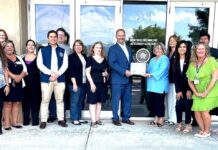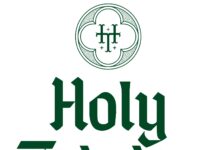
By Carol Mowdy Bond
Contributing Writer
Nestled into the heart of Yukon, and sometimes known as “The Silos,” the structures of the original Yukon Mill and Grain Company, and Dobry Mills, tower over Route 66.
However, a developer is proposing a sweeping change that may impact the citadels, as well as the look and feel of Yukon’s historic area along both the north and south sides of Main Street or Route 66.
David Jones, owner of David Jones Commercial Real Estate in Dallas, is proposing a plan that includes a new five-story, high end office park, apartment building, two multi-level parking garages, and a hotel and convention center on Main Street.
Jones said the historic value of landmark Yukon buildings, including the original Yukon Mill and Grain Company and Dobry Mills, is to be preserved in the plan. But Urban Boondocks Market owner Desiree Reid said her business at 115 W. Main Street, which sits in the shadows of the towering landmarks, is missing from the online plans. The online plan also shows a proposal for a Yukon Technology Center to be built at 219 W. Main with 144,000 to 300,000 square feet of office retail space.
The Yukon Mill and Grain Company and Dobry Mills structures are engrained in Yukon’s narrative, and are still in use today. They are also an integral part of Yukon’s small town feel, as well as the city’s quaint, historic Main Street District. The preservation of that district, or corridor, which runs along Main Street from Cornwell to Garth Brooks Boulevard, has been the focus of several organizations for a number of years.
Within walking distance of the mill and grain elevator locations, architectural gems reach back over a century in time, and summon voices from the past. On Main Street, from 4th Street to 5th Street, are many structures which are still in use today, including: Yukon’s first brick business building, the Wheatley Building located at 459 W. Main Street, which A.N. Spencer built in 1891; the Bass Building located at 456 and 458 W. Main Street and built in 1898; the Mulvey Mercantile’s primary building at 425 W. Main Street, built in 1904 by the Irish twins Odie and Mike Mulvey and known as “Yukon’s Big Store,” which rapidly expanded, eventually including half the buildings on the north side of Main Street. Mulvey Mercantile was the largest retailer in Yukon until the 1930s, and possibly the largest retailer in Oklahoma. These locations don’t include numerous historic structures and experiences radiating out from that one-block area.
Perched next to the railroad tracks, the mill and grain structures are situated on the north and south sides of Main Street. And they are tied to the original entrepreneurs and area residents who propelled much of Yukon’s growth. Industrious and determined, both they and their descendants are still significantly impacting the world today.
Those who traverse Route 66 recognize the mill and grain citadels as familiar landmarks. Looking out across Canadian County’s prairie on a clear day, the beacons can be seen from miles away, and are well known throughout the county and region.
Initially, Native American groups were actively present in today’s Canadian County. And they continue to have a global impact. As well, a buffalo trace ran through the prairie grasses. Herds of cattle rumbled along the Chisholm Trail. And the 1889 Land Run brought settlers who farmed the area.

THE SPENCER FAMILY
As Texas cattle ranchers, cowboys, and entrepreneurs, the Spencer brothers, Augustus “A.N.” Spencer and Lewis “L.M.” Spencer, noticed today’s Yukon area while driving their herds on the Chisholm Trail. Both men invested themselves in Indian Territory’s railroads, and they became cattle ranchers in Texas, riding up and down the Chisholm Trail with their herds. A.N. Spencer also had cattle in New Mexico and Kansas.
One of the Spencer brothers, William Spencer, built some of Yukon’s first-of-their-kind buildings. Various of the Spencer siblings quickly purchased land and erected buildings. At some point, A.N. Spencer managed to bring the Choctaw, Oklahoma and Gulf Railroad, or COG, later known as the Rock Island Railroad, through Yukon. And that was the pivotal catalyst for creating a bustling and prosperous Yukon. The small settlement quickly burst into a thriving hub of activity and a big draw for farmers, merchants, and businessmen.
The original Feb. 17, 1891, plat Yukon’s town site shows the COG train tracks steaming through Yukon. The Yukon post office was established March 28, 1891. But the railway didn’t chug through Yukon until April. Prior to that, mail came through other means.
By late 1891, the Spencers and their associates splashed a flurry of growth onto the landscape, causing others to relocate to the area. And today’s Main Street was originally known as Spencer Avenue.
THE KROUTIL AND DOBRY FAMILIES
In 1893, a small grain elevator was founded. By 1898, a large Czechoslovakian population was gravitating to Yukon.
That population mushroomed over time, and today Yukon is known as the Czech Capital of Oklahoma.
John Kroutil was born in 1875 in Bohemia (today’s Czechoslovakia) near Prague. John Kroutil, and his brother Frank Kroutil and their parents, emigrated from Bohemia in 1881.
They first settled in Nebraska, and relocated to an El Reno farm in Oklahoma Territory somewhere between 1890 and 1895.
In 1902 or 1903, John Kroutil and his brother Frank Kroutil and A. F. Dobry purchased a small coal business that also handled some wheat and corn. In so doing, they acquired the small grain elevator and mill that were built in 1893, giving birth to the Yukon Mill and Grain Company. John Kroutil became president of the mill, with Frank Kroutil as the vice president.
John Kroutil and Frank Kroutil installed steam-powered electric generators to run the flour mill. The generators were really big, allowing Yukon to be one of Oklahoma’s first small towns to enjoy electricity. John Kroutil served as the president of the Yukon Electric Company, which was formed in 1907, the year of Oklahoma’s statehood. In 1960, OG&E bought the rights to provide Yukon’s electricity.
In 1918, John Kroutil built the mill’s large office building, still located at 301 West Elm, immediately west of the Yukon Mill. And over time, the Kroutil brothers cranked up their operations. The mill became the largest flour plant in the state and the Southwest. By the 1930s, the mill had the capacity to produce 2,000 barrels of flour per day. And from the Yukon area, they exported “Yukon’s Best Flour” to every state in the U.S., and to some locations abroad.
The Dobry family sold out to the Kroutils in 1933. And Ethel and Joe Dobry founded Dobry Flour Mills across the street, on the north side of Main Street.
Throughout the 20th century, the Kroutil and Dobry operations transferred into different hands. But the grain elevators are still in use today. And generations of childhood memories swirl around school tours of the mills and grain elevators, when children received miller caps and small bags of flour.






